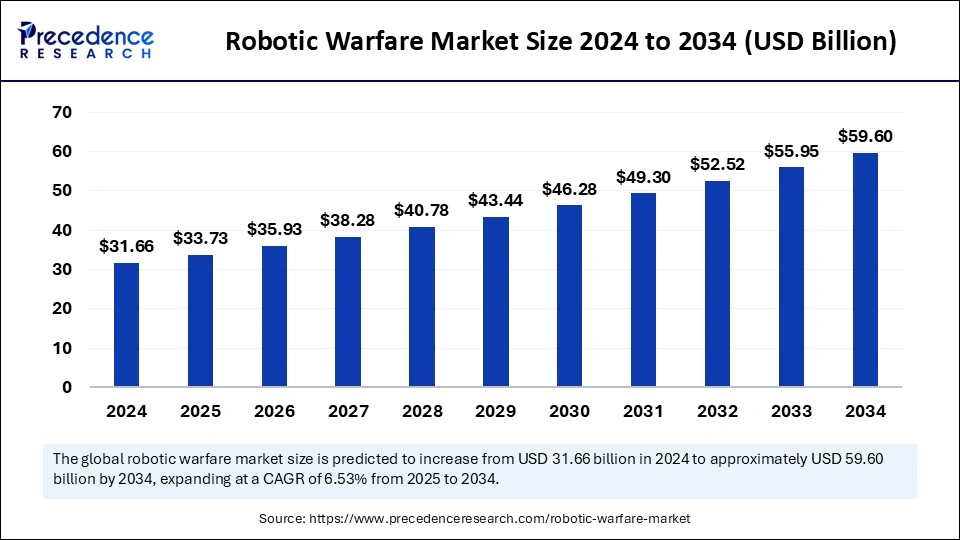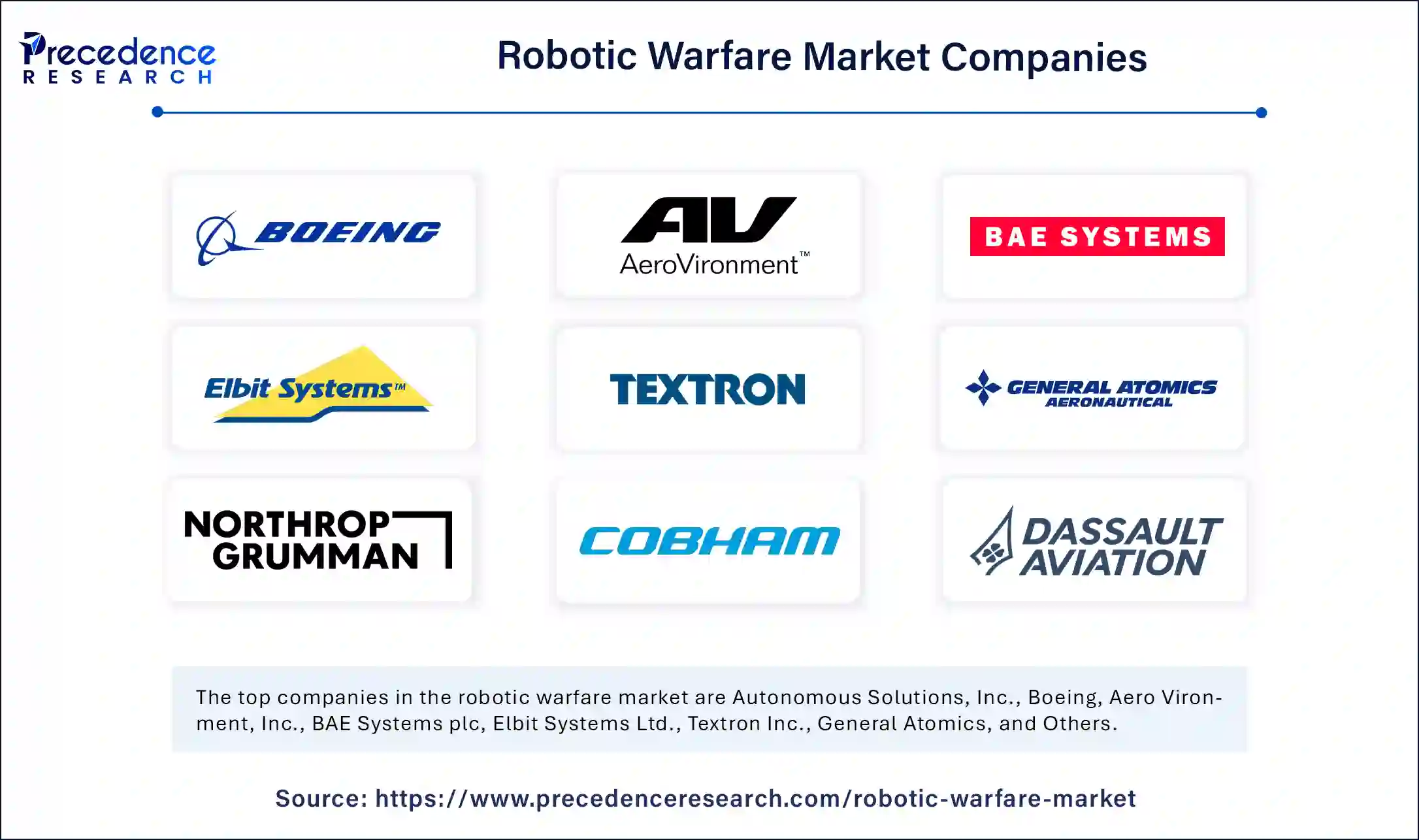Robotic Warfare Market Size to Soar USD 59.60 Billion by 2034
Robotic Warfare Market Size and Forecast 2025 to 2034
The global robotic warfare market size was valued at USD 31.66 billion in 2024 and is expected to soar around USD 59.60 billion by 2034, growing at a CAGR of 6.53% from 2025 to 2034.

Get a Free Sample Copy of the Report@ https://www.precedenceresearch.com/sample/5813
Robotic Warfare Market Key Insights
-
The North American region led the global market in 2024, accounting for 41% of the share.
-
Asia Pacific is projected to grow at a strong CAGR over the forecast period.
-
The semi-autonomous mode of operation captured the largest market share in 2024.
-
The unmanned platforms and systems segment held a considerable share by capability in 2024.
-
The exoskeleton and wearables segment is expected to grow at a rapid pace during the forecast period.
-
In 2024, the intelligence, surveillance, and reconnaissance application segment led the market.
-
The search and rescue application segment is projected to grow quickly in the coming years.
Impact of Artificial Intelligence on the Robotic Warfare Market
-
Autonomous Decision-Making
AI-powered robots are equipped with decision-making capabilities that allow them to operate autonomously. These robots can assess the battlefield, make strategic decisions in real-time, and respond to threats without human intervention. This reduces the risk to human soldiers and enhances mission efficiency, especially in high-risk environments. -
Advanced Targeting and Precision
AI enhances the precision of robotic warfare systems, particularly in targeting and navigation. AI algorithms enable systems to identify and engage targets with a higher level of accuracy. This minimizes collateral damage, making military operations more efficient and reducing unintended harm to civilians and infrastructure. -
Real-Time Data Processing and Situational Awareness
AI allows robotic systems to process vast amounts of data from sensors, satellites, drones, and other sources. This real-time data analysis helps improve situational awareness, enabling military forces to make faster and more informed decisions. AI-driven robots can detect threats, track enemy movements, and optimize responses based on the evolving battlefield scenario. -
Enhanced Tactical Flexibility
AI increases the tactical flexibility of robotic warfare systems. These systems can adapt to changing environments and mission requirements, learning from experience and improving their performance over time. AI systems can adjust their behavior based on new data inputs, allowing them to adapt quickly to diverse combat situations. -
Swarm Robotics
AI facilitates swarm robotics, where multiple autonomous robots work together to accomplish a task, such as surveillance, reconnaissance, or even combat. These robots can communicate with each other and coordinate their actions, mimicking natural swarms of insects or animals, thus increasing operational efficiency and versatility. -
Improved Security and Cyber Defense
AI helps enhance the cybersecurity of robotic systems used in warfare. By detecting and responding to cyber threats in real time, AI strengthens the defense capabilities of robotic systems, ensuring they are not vulnerable to hacking or other cyberattacks that could compromise mission success. -
Cost-Effectiveness and Scalability
AI-driven robotic systems are designed to be scalable, meaning that large numbers of robots can be deployed at relatively lower costs compared to traditional manned units. AI helps in minimizing the costs associated with training, deployment, and maintenance, making robotic warfare systems more affordable and accessible to a broader range of military forces.
Robotic Warfare Market Growth Factors
-
Advancements in AI and Robotics Technology
Continuous innovations in artificial intelligence (AI), machine learning, and robotics are enhancing the capabilities of robotic warfare systems. These advancements enable robots to perform more complex tasks autonomously, improving decision-making, targeting, and operational efficiency on the battlefield. -
Increased Military Budget Allocations
Governments worldwide are increasing their defense budgets to modernize their armed forces and keep pace with technological advancements. As part of this, they are investing heavily in robotic and autonomous systems to improve combat capabilities, enhance safety, and reduce operational costs. -
Minimizing Human Casualties
Robotic warfare systems reduce the need for human soldiers in high-risk combat situations, thereby minimizing casualties and ensuring safer military operations. The desire to protect soldiers from hazardous environments, such as in combat zones or dangerous reconnaissance missions, is a significant driver of market growth. -
Enhanced Surveillance and Reconnaissance Capabilities
Robotic systems, such as drones and unmanned ground vehicles, offer improved surveillance, reconnaissance, and intelligence-gathering capabilities. These systems provide real-time data analysis, aiding in mission planning and execution, and offer a strategic advantage over adversaries. -
Increased Adoption of Autonomous Systems
The growing reliance on autonomous and semi-autonomous systems in various sectors, including defense, is driving the robotic warfare market. The ability of autonomous robots to operate with minimal human intervention increases their efficiency and effectiveness in combat, surveillance, and logistics. -
Swarm Robotics Technology
Swarm robotics, which allows multiple robots to coordinate and operate together as a collective unit, is gaining traction in military applications. This technology enables efficient, scalable operations for tasks like reconnaissance, search-and-rescue missions, and offensive operations, contributing to market expansion. -
Improved Cybersecurity Features
As robotic warfare systems become more sophisticated, there is a growing emphasis on developing advanced cybersecurity measures to protect them from cyberattacks. Enhanced security features make these systems more reliable and safer for deployment, driving their adoption by military forces. -
Strategic Geopolitical Shifts
Global geopolitical tensions and regional security concerns are leading to an increased demand for advanced defense systems, including robotic warfare technologies. Military forces are looking to stay ahead of adversaries by adopting cutting-edge robotics to maintain their technological edge. -
Cost-Effectiveness and Scalability
Robotic warfare systems can offer a cost-effective alternative to traditional military assets, such as manned aircraft, ground vehicles, and naval vessels. Their scalability allows for widespread deployment, making them accessible to a wide range of defense forces across various budgets. -
Global Military Modernization Programs
Many nations are undergoing large-scale military modernization programs to update outdated defense infrastructure. Robotic warfare systems are being integrated into these modernization efforts to improve capabilities and prepare for future threats in an increasingly technology-driven combat environment.
Market Scope
| Report Coverage | Details |
| Market Size by 2034 | USD 59.60 Billion |
| Market Size in 2025 | USD 33.73 Billion |
| Market Size in 2024 | USD 31.66 Billion |
| Market Growth Rate from 2025 to 2034 | CAGR of 6.53% |
| Dominated Region | North America |
| Fastest Growing Market | Asia Pacific |
| Base Year | 2024 |
| Forecast Period | 2025 to 2034 |
| Segments Covered | Mode of Operation, Capability, Application, and Regions |
| Regions Covered | North America, Europe, Asia-Pacific, Latin America and Middle East & Africa |
Market Dynamics
Key Drivers
The market is being driven by the growing emphasis on reducing military casualties, the increasing reliance on AI and autonomous systems in defense, and the demand for enhanced surveillance, reconnaissance, and precision-targeting capabilities. The need for modernized, advanced warfare solutions is pushing nations to invest in robotic systems that can enhance their strategic capabilities.
Opportunities
The integration of AI into robotic warfare systems offers numerous opportunities for the development of smarter, more adaptive machines. Additionally, the growing interest in robotic swarm technology presents an exciting avenue for military applications, enabling coordinated actions across multiple units. The expansion of defense modernization projects in developing countries is also a major opportunity for growth.
Challenges
Despite its potential, the robotic warfare market faces several challenges. These include the high cost of research and development, the difficulty of maintaining complex robotic systems, and the regulatory and ethical concerns surrounding the use of autonomous weapons. Furthermore, security risks like cyberattacks on robotic platforms could undermine their reliability in critical combat situations.
Regional Insights
North America holds the largest share of the robotic warfare market, largely driven by the United States’ defense investments and technological advancements. Europe is also growing rapidly due to its collaborative defense initiatives and technological development in robotics. In the Asia-Pacific region, countries like China and India are making significant strides in adopting robotic technologies to enhance their military capabilities.
Robotic Warfare Market Companies

- Autonomous Solutions, Inc. (ASI)
- Boeing
- Aero Vironment, Inc.
- BAE Systems plc
- Elbit Systems Ltd.
- Textron Inc.
- General Atomics
- Northrop Grumman Corporation
- Cobham plc
- Dassault Group
- Lockheed Martin Corporation
- Thales Group
Recent Developments
- In January 2025, L3Harris attached an advanced multirole electronic warfare (EW) capability to a T7 robot and demonstrated it at Vanguard 2024, an annual capstone experiment the U.S. Army hosts at Fort Huachuca, Arizona. This attached detected and defeated small unmanned aircraft systems (sUAS) with the CORVUS-RAVEN system and sensed, monitored, and decoded electronic signals using the Individual CORVUS Node.
- In February 2025, Estonia-based Milrem Robotics revealed its new 8×8 wheeled combat robot, dubbed Havoc, a mockup of a new hybrid-electric vehicle.
In March 2025, Ukraine established the world’s first Unmanned Systems Forces (USF) to advance unmanned and robotic warfare capabilities across air, sea, and ground domains.
Segment Covered in the Report
By Mode of Operation
- Autonomous
- Semi-Autonomous
By Capability
- Unmanned platforms & systems
- Exoskeleton & wearables
- Target acquisition systems
- Turret and weapon systems
By Application
- Intelligence, Surveillance, and Reconnaissance
- Logistics and Support
- Search and Rescue
- Combat and Operations
- Tracking and Targeting
- Training and Simulation
By Region
- North America
- Europe
- Asia Pacific
- Latin America
- Middle East and Africa
Also Read: High Voltage Direct Current (HVDC) Capacitor Market
Ready for more? Dive into the full experience on our website@ https://www.precedenceresearch.com/
